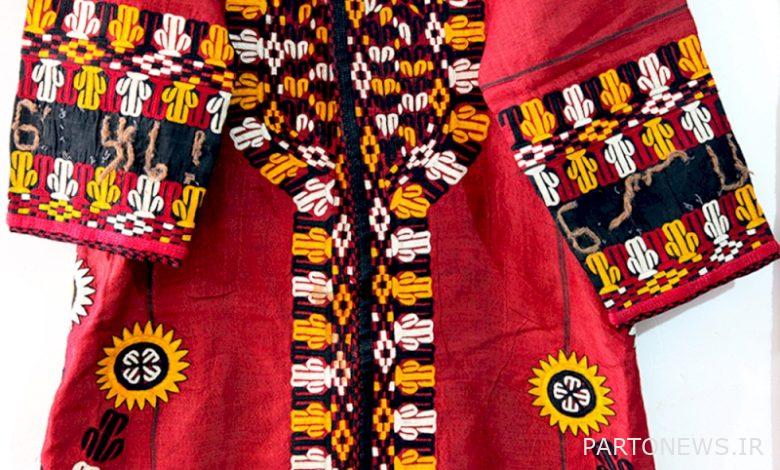Analysis of Turkmen clothing in Golestan province

In every culture and society, there is a set of beliefs about clothing and its elements. Different and similar beliefs about different components, colors and materials of clothing can be found in different parts of Iran.
Once clothing is placed in the context of a spiritual belief, ritual, or chapter, it is no longer just a simple cover, but has deep meanings of its own. Beliefs are passed down from generation to generation, and in this transmission the environment is affected, changed, and may even be forgotten. The introduction of technology into people’s lives causes beliefs to be forgotten, and many of them are now only remembered. این Many of these beliefs have now faded and some have been forgotten due to social change, migration to cities, communication with people in other cities and regions, weakening of social relations between individuals, and so on.
One of the tools of cultural cognition of societies is clothing and its related elements. Each item of clothing, material and color of fabric, design and shape of sewing clothes and its arrays and ornaments symbolically convey a concept or concepts. The garment reflects the social, economic, religious and occupational status of the person wearing it and reflects the class status of the person in different social groups. Also clothing and type, material, color and shape of its sewing and vocabulary and terms related to clothing with moral and spiritual values and criteria such as shame and modesty, dignity and sobriety, attraction and charm, greatness and humiliation, pride and humility, Sexual attraction, importance and prestige, mourning and mourning and joy and happiness, poverty and wealth and religious insights are linked.
Turkmen women’s clothing
Traditional Turkmen women’s clothing is long shirts, pants, headbands and hats. The shirt is a long, silk garment that they weave themselves. Turkmen silk is woven in a simple machine called “tara” in the form of narrow loops. Each niche is 2.5 to 5 meters long and 30 to 40 cm wide and is mostly in the form of red stripes with yellow stripes. With this silk shawl, a simple and long shirt is embroidered, which is called red or quink. They wear trousers under the quince and trim the bottom of the trousers up to the knees with colored and embroidered silk. Embroidered designs on garments are usually designs of ram’s horn, triangle, circle, or motifs specific to each tribe.
Needlework is also used for the sleeves, collar and chest of the shirt. The hat and headband represent both the female clan and the marriage or celibacy of the person. Before marriage, girls wear simple scarves and embroidered hats, and after marriage, hats in the form of incomplete cones made of straw or broomsticks. The hat is covered with a scarf and a large handkerchief of silk or thread is placed on it, which covers the mouth with one end. This handkerchief is called Yashmaq. Older women have smaller hats and black headbands. Women use special ornaments. Some of these ornaments are for the head and forehead or around the hat and some are for decorating the hair. Breasts, earrings, bracelets and bracelets are some of the ornaments of Turkmen women. All ornaments are made by the Turkmen themselves and are made of silver, agate and sometimes colored glass.
Analysis of Turkmen women’s clothing
1- Design: Turkmen women’s clothing design has simple cuts, vertical lines and geometric pieces. As in the cuts of leggings and women’s pants, this type of cuts is also used. These designs, which have always been preserved over time, have original and primitive (ancient) features. Due to the fact that the raw materials of their clothes are mostly handmade silk or cotton fabrics and these fabrics are usually woven in a width of 30 cm, so it can be said that the design of their clothes is due to the design and texture of handmade fabrics and the width of the fabric. The result of fabric texture design and clothing design has a special harmony.
2- Appearance: Loose clothing is affected by climatic conditions and lifestyle in the desert and plains. Therefore, the clothing of Turkmen women was light and easy to move for daily work. In this appearance, they have been faithful to the design of their clothes until now.
3- Clothing color: The colors used in clothing and its components in women’s clothing have been in red and crimson colors, which has had a special visual effect due to the hot, dry and desert climate of the region, and in addition, the red color of Yemen is widely used. Provided for the use of this color.
Color is used in Turkmen tribes with a special philosophy of existence. It is a sign of heart and fire, which includes youth and the yard among older women. However, in many local tribes of Iran, different colors and decorations are considered for age groups. In the past, only yellow, red, white, and black were used among Turkmen women. With the philosophy that red is the color of blood flowing in the arteries of life. The color of happiness, health and happiness and human well-being, and in contrast, yellow is a symbol of disease, suffering, failure and failure. With this deep and philosophical view that two opposite elements are always complementary and the cause of the flow of life, if there is happiness, sadness should be in front of it, so that happiness finds meaning and meaning, and white is the color of happiness and light, the color of day and black is the color of night. Death and color are nothing. White and black identify together and evoke an interpretation of birth and death. Usually, two colors of black and white are used to start needlework, which in Turkmen terms are called “Qaralama and Aqalama” (Qara means black and Aq means white).
4- Designs: Patterns used in Turkmen women’s clothing include elements of nature (sun, moon and stars), animal motifs (ram horn, chicken, chicken paw, camel neck, bird wings, snake mouth, scorpion, sparrow nails, twisted ram horn), motifs Plants (potted flowers, marigolds, hourglasses, pines, shrubs, artichokes), objects (sugar crushers, pliers, scales, wooden boxes, candles, candle holders, anchors, banknotes), geometric patterns (forty-piece pattern, seven-piece pattern and Vestibule, checkerboard, Roman band) and….
In a more comprehensive view, the anthropology of the Turkmen people can be introduced in three categories:
A) Beliefs and beliefs, for example, concealment is one of the prominent characteristics of clothing due to social and cultural status.
B) Environmental and climatic factors that take into account the type and type of clothing and even sewing and clothing components and materials preparation techniques.
C) Conditions and social relations such as the type and manner of livelihood, traditions, ceremonies are among the factors affecting the type and manner and durability of clothing.
.

